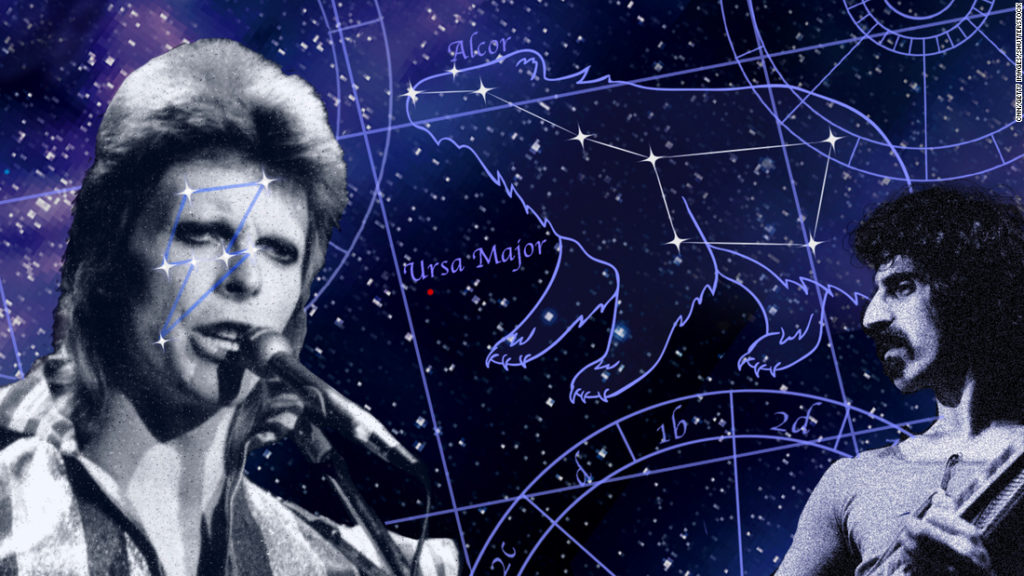
You might even be able to pick out a small star there, in the middle of the handle of the Big Dipper. It’s called Alcor, a binary star paired with the nearby, brighter Mizar, Arabic for “cloak.” In Arabic, the former star is called al-Khawwar, “the faint one,” and finding it made for a good eye test in the days before wall charts.
“He can see Alcor,” an Arabic proverb has it, “but not the full moon,” akin to not being able to see the forest for the trees.
Arabic, Latin, English: three languages appear side by side in that one constellation, the third largest of the 88 constellations in the night sky. Along with them are Greek characters and an alphabet soup of letters and numbers employed by a variety of star catalogs.
Alcor has so many names — 80 Ursae Majoris, g Ursae Majoris, HD 116842, GC 18155, HIP 65477, SAO 28751, PPM 34021 — and the list goes onto 80 UMa Ca, the designation approved by the International Astronomical Union, the ultimate arbiter of such things.
There are countless objects up there in the sky: planets, stars, comets, constellations, moons. And for every one of the ones we can see with our eyes or with powerful telescopes, there’s a name that some Earthling has given it. Those names number in the millions and come from many languages. Just as astronomers and space scientists have their favorites among all these celestial bodies, they have their favorite names as well.
A constellation of languages
Arabic is so prominent in the names of the stars because Arabic scholars preserved and studied thousands of Greek and Latin manuscripts lost to Europe during the Dark Ages. So it is that the brightest star in Orion, the constellation named for a Greek demigod, is called Betelgeuse, “the arm of the giant.” Its companion is called Rigel, Arabic for “foot.” Elsewhere, the brightest star in the zodiacal constellation Taurus is called Aldebaran, whose Arabic name is thought to mean “following behind,” since it appears to tag along with the movements of the Pleiades.
“My favorite star names are Zubenelgenubi and Zubeneshamali, the two brightest stars in the constellation Libra,” said astrophysicist and science ambassador Neil DeGrasse Tyson, host of the entertaining “StarTalk” science podcast.
“I was intrigued by their names from childhood—long before I learned of their Arabic origins and the seminal contributions of Arabic scholars to astronomy, navigation and other fields,” he said. “The names translate to Southern and Northern Claw of the scorpion, back when parts of Libra were considered parts of a more floridly illustrated Scorpio.”
By long historical convention, constellations and star groups known to the Greeks and Romans bear Greek and Latin names, as do all the planets in our solar system save ours. Many of those names come from mythology. For instance, those Pleiades—a star cluster also known as Messier 45, honoring an 18th-century French astronomer, and located above Aldebaran—take their name from seven sisters whom Zeus turned into stars. In Japanese, incidentally, the Pleiades are known as Subaru, from which the automobile company takes its name.
Some classical names refer to location or appearance. Our Milky Way comes from Greek by way of Latin; the ancient Via Galactica, or “road of milk,” for that huge band of white stars, also gives us our word “galaxy.” Sirius, the brightest star in the heavens, takes its name from the Greek word for “scorching,” since it dominates the sky in the “dog days” of summer, while its neighbor Procyon rises a little earlier than the so-called Dog Star, its name meaning “before the dog.” And Polaris is so called because it stands above what geographers call geodetic north, the “true North Pole.” It will earn its name until some other object takes its place as the pole star, stella polaris, centuries from now.
Latin is everywhere in the sky, commemorating not just ancient Roman science but also the fact that Latin was the international language of learning for many centuries. By another convention, all the zodiacal constellations bear Latin names, while names such as our “Sea of Tranquility,” where Apollo 11 landed under the sure hands of Michael Collins, Neil Armstrong and Buzz Aldrin, is a direct translation of the Latin “Mare Tranquillitatis.”
Diversifying the astronomical catalog
To its credit, the International Astronomical Union has been working over the last few years to broaden the reach of star names to include non-European cultures, favoring easily pronounceable words of between 4 and 16 characters. Alcor, the ancient name that the IAU formally recognized less than five years ago, fills the bill nicely.
So does Xuange, or Λ Boo, in the Greek-named constellation Boötes, “the ox driver.” The Chinese name means “somber lance.” Pipirima, or μ² Sco, in the zodiacal constellation of Scorpius, commemorates a Tahitian myth in which a brother and sister run away from home and become stars. And Chamukuy, or θ2 Tau Aa, in Taurus, honors the advanced astronomical knowledge of the ancient Maya, its cultural name referring to a small bird.
The IAU has also been active in naming celestial features for people overlooked by mainstream scientific institutions in the past. The 900-odd craters of Venus and many other physical features, for example, are named for women, real and mythological: Danilova honors the Russian ballet dancer Maria Danilova, Hansberry the American playwright Lorraine Hansberry, and Adivar the Turkish writer Halide Edip Adivar, while Seymour commemorates Jane Seymour, the English queen who married Henry VIII and died after giving birth to the future Edward VI.
In that same inclusive spirit, recently named craters on Mercury record the names of Bangladeshi painter Zainul Abedin, Japanese writer Ryunosuke Akutagawa, Hopi potter Nampeyo, American poet Maya Angelou, and Austrian composer Gustav Mahler.
Occasionally, even astronomers themselves make an appearance in the catalog of heavenly names. Marcia Rieke, the principal investigator for the near-infrared camera on the James Webb Space Telescope, which is scheduled to be launched on October 31, said: “I’ve always liked the name for a comet that was discovered in 1930. This comet is named Schwassmann–Wachmann after the two astronomers that discovered it. I like the alliteration in the two names.”
When it comes to exoplanets and minor celestial bodies, the rules are less formal, and the IAU occasionally runs naming contests. In 2013, a nine-year-old boy from North Carolina won for naming a previously uncatalogued asteroid Bennu, after the Egyptian god often depicted as a heron, the living symbol of the god Osiris—which makes it fitting that the spacecraft that landed on it in 2018 bears the name OSIRIS-REx (for Origins, Spectral Interpretation, Resource Identification, Security-Regolith Explorer).
Other asteroids bear more secular names, such as 4442 Garcia, named for Jerry Garcia of the Grateful Dead, and 3834 Zappafrank, honoring the decidedly centrifugal musician and political activist. And just a year before his death in 2016, the famed British singer and songwriter David Bowie, a fan of space travel and science fiction, earned his place in the sky with 342843 Davidbowie. He really deserved a star, but IAU rules forbid that honor.
Indigenous names
As you step out tonight to watch the full moon rise, give some thought to the names the Indigenous people in your neighborhood call it. The Tohono O’odham, in whose homeland I live, call the full moon of May U’us Wihogdad Maṣad, or “mesquite bean–growing moon.” The Cherokee people, whose original homeland lay in the forests near the Great Smoky Mountains, call it a nas gv ti, or “month of the planting moon.”
“Words have power,” Conrad said, “and by choosing to name a place one is exploring by placing an emphasis upon respect, we can make incremental change.” And her favorite name in space? It’s Máaz, the Diné name for Mars, a name the team bestowed on the first rock formation Perseverance encountered.
With perhaps a septillion (that’s a 1 followed by 24 zeros) of stars in the universe and at least 100 billion in the Milky Way alone, there are plenty of opportunities to add names to the celestial catalogues. However, the IAU warns, no matter how well connected you might be in the world of astronomy, politics, or pop culture, you can’t “buy” a star name that has any official weight, even though there are numerous companies that offer to sell them.
You’d do better to wait until Valentine’s Day, a birthday, or some other special day and send a card telling the intended recipient that whenever you see HR 7924 (Deneb), HD 93083 (Macondo), or HR 7377 (Delta Aquilae), you’ll think of that person and blow a kiss their way.
Gregory McNamee writes about books, science, food, geography and many other topics from his home in Arizona. CNN’s Ian Berry provided illustrations for this piece.
You may also like
-
Afghanistan: Civilian casualties hit record high amid US withdrawal, UN says
-
How Taiwan is trying to defend against a cyber ‘World War III’
-
Pandemic travel news this week: Quarantine escapes and airplane disguises
-
Why would anyone trust Brexit Britain again?
-
Black fungus: A second crisis is killing survivors of India’s worst Covid wave

